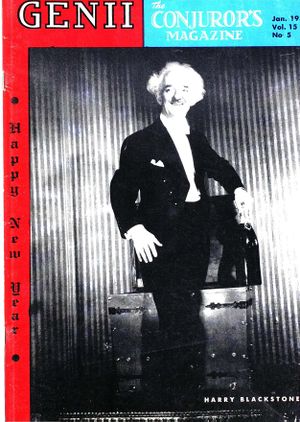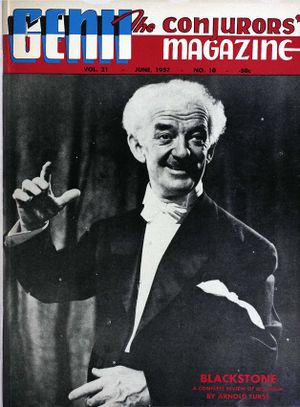Help us get to over 8,756 articles in 2024.
If you know of a magician not listed in MagicPedia, start a New Biography for them. Contact us at magicpediahelp@gmail.com
Harry Blackstone Sr.
| Harry Blackstone Sr. | |
 (1938) | |
| Born | Harry Boughton September 27, 1885 Chicago, Illinois |
|---|---|
| Died | November 16, 1965 (age 80) Hollywood, California |
| Resting place | Lakeside Cemetery, Colon Michigan |
| Known for | Classic Grand Stage Illusions |
Harry Blackstone (September 27, 1885 - November 16, 1965) was born Harry Boughton, of Jewish parents and was raised in Chicago, Illinois.[1]
He began his career as a magician in his teens and was popular through World War II as a USO entertainer. He was often billed as The Great Blackstone. His son Harry Blackstone, Jr. also became a magician.
Biography
Blackstone was in the mode of courtly elegant predecessor magicians like Howard Thurston and Harry Kellar. He often wore white tie and tails when performing, and he traveled with large illusions and a sizable cast of uniformed male and female assistants. For a number of years he toured in the Midwest, often performing throughout the day between film showings.
Blackstone remained silent during much of his big stage show, which was presented to the accompaniment of a pit orchestra and such lively tunes of the time as "Who," "I Know That You Know," and "Chinatown."
Among his especially effective illusions was one in which a woman lying on a couch and covered with a gossamer shroud appeared to float high in the air and then vanish, as Blackstone pulled off the covering. In another illusion, a woman stepped into a cabinet in front of many bright, clear, tubular incandescent light bulbs. When the magician suddenly pushed the perforated front of the cabinet backward, she seemed to be pierced as it appeared through the holes in the front of the box (to the accompaniment of her blood-curdling scream). The cabinet was then revolved so that the audience seemed to see the lady impaled by the blinding filaments.
His " Sawing a Woman in Half" illusion involved an enormous electric circular saw, some three to four feet in diameter, mounted on a swing-down arm. Blackstone demonstrated the efficacy of the device by sawing noisily through a piece of lumber. Then a gossamer-clad assistant was placed on the saw table in full view, as wide metal restraints were placed upon her mid-section. The blade whirred and appeared to pass through her body, as the ripping sound of (wood?) was heard, the woman shrieked, and particles were scattered by the whirring blade. the blade was stopped, and she, of course, arose unharmed.[2]VIDEO
In a gentler turn was his "Vanishing Bird Cage," an effect in which a score or more of children were invited to join him on the stage and all "put their hands on" a tiny cage holding a canary. Blackstone lowered the cage and then seemed to toss it into the air, bird and cage "disappearing" in the process, to the astonishment and delight of the surprised children.
Among his lovelier effects was "The Garden of Flowers," in which countless bouquets of brilliant feather flowers appeared from under a foulard and on tables and stands until the stage was a riot of color. "The Floating Light Bulb" was perhaps his signature piece. In a darkened theater, Blackstone would take a lighted bulb from a lamp and float it, still glowing, through a small hoop. He would then come down from the stage and the lamp would float out over the heads of the audience.
Blackstone and Percy Abbott formed the Blackstone Magic Company in 1928, but it only lasted a little over a year.
Blackstone spent the last years of his life performing at The Magic Castle, in Hollywood, California.
He died at the age of 80 and was interred close to his former home in Colon, Michigan, where the main street was renamed Blackstone Avenue in his honor.
Radio
Blackstone, the Magic Detective was a 15-minute radio series which aired on the Mutual Broadcasting System from 1948 until 1950.
Comics
Blackstone was used as a character in a series of comic books. "Blackstone, Master Magician" comics started in 1946 and ran for three issues. It was renamed "Blackstone The Magician Detective" which also ran for three issues. There was also in the 1940s the "Pennzoil Presents Blackstone Master Magician", an 8 pages comic book format of trick instructions.
References
- ↑ Genii 1951 January (cover)
- ↑ VIDEO: Harry Blackstone, Sr. performing his buzz-saw "Sawing a Woman in Half" illusion in 1934 - "YouTube Vintage Magic Archives"[1] Accessed 2015-07-21
| This page incorporated content from Harry Blackstone Sr.,
a page hosted on Wikipedia. Please consult the history of the original page to see a list of its authors. Therefor, this article is also available under the Creative Commons Attribution-ShareAlike License |
- The Sphinx, Vol. XXXIV, No. 3, May 1935, Harry Blackstone, page 68
- The Bat, No. 23, November 1945, MAGICIAN NO. 1 By MAURICE ZOLOTOW, pages 121-124
- Genii, Vol. 21, No. 10, June 1957, Blackstone A Review of His Show At The Biltmore Theatre, Los Angeles, California BY ARNOLD FURST, page 380
- M-U-M, Vol. 52, No. 4, September 1962, HARRY BLACKSTONE magician-of-the-month by LESLIE P. GUEST, page 186
- The New TOPS, Vol. 5, No. 12, December 1965, THE GREAT BLACKSTONE, page 8
- The Linking Ring, Vol. 45, No. 12, December 1965, Broken Wand HARRY BLACKSTONE, page 121
- The New Tops, Vol. 9, No. 11, November 1969, 1885 - Harry Blackstone - 1965, "I remember ..." by David Price, page 24
- M-U-M, Vol. 98, Nr. 4, September 2008, THE NIELSEN GALLERY, BLACKSTONE, page 58
- Photo Genii 1952 June
- Blackstone: A Magician's Life by Daniel Waldron (1999)

